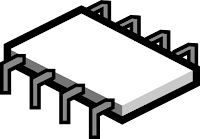This is a demonstration of the concept of paging using assembly language. Here each page has been declared as an array. And address variable(add) denotes the address which is to be reached. This is assumed to be similar to linear address. This is to be translated to physical address using the concept of paging.
Assembler:- NASM
Platform:-x86 (32 bit ALP)
[SE@localhost ~]$ ld -m elf_i386 -o page page.o
[SE@localhost ~]$ ./page
u
[SE@localhost ~]$
Code
OS:- Linux 64 bit(Fedora)Assembler:- NASM
Platform:-x86 (32 bit ALP)
;Author:-Abhishek Munagekar ;Program:- To demonstrate paging tables section .data p0 : db "01234567" p1 : db "abcdefgh" p2 : db "ABCDEFGH" p3 : db "zyxwvuts" add : dd 00010105h msg db "Multiplication is" section .bss pdir resb 8 pf0 resb 8 pf1 resb 8 temp resb 4 count : resb 01 global _start section .text _start: mov eax, p0 ;initializing frame1 mov esi, pf0 mov [esi], eax add esi,4 mov eax,p1 mov [esi], eax mov esi,pf1 ;initializing frame2 mov eax,p2 mov [esi], eax add esi,4 mov eax,p3 mov [esi],eax mov esi,pdir ;initializing directory mov eax,pf0 mov [esi],eax add esi,4 mov eax,pf1 mov [esi],eax ;page tables have been generated mov eax,[add] and eax,00FF0000h rol eax, 16 mov [count],al mov esi,pdir sub esi,4 inc byte[count] begin: add esi,4 dec byte[count] jnz begin mov eax,dword[esi] mov [temp],eax mov esi,[temp] ;reached frame mov eax,[add] and eax,0000FF00h ror eax,8 mov [count],al inc byte[count] sub esi,4 begin2: add esi,4 dec byte[count] jnz begin2 mov eax,dword[esi] mov [temp],eax mov esi,[temp] ;reached page mov eax,[add] mov [count],al dec esi inc byte[count] begin3: add esi,1 dec byte[count] jnz begin3 ;reached the correct value using offset mov al,byte[esi] ;move the value to printed in count mov [count],al mov eax,4 ;write system call mov ebx,1 mov ecx,count mov edx,1 int 80h mov eax,1 ;exit system call mov ebx,0 int 80h
Output
[SE@localhost ~]$ nasm -f elf page.asm[SE@localhost ~]$ ld -m elf_i386 -o page page.o
[SE@localhost ~]$ ./page
u
[SE@localhost ~]$


No comments:
Post a Comment